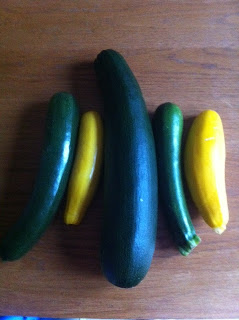Courgettes & Comfrey
I wanted to make some Comfrey 'tea' to feed our new plot. We always had it on the Hydro Farm so while I was in Blarney recently I paid a visit to catch up with plotting friends. I met Zwena, Rosie & Tom and came home with an armfull of Comfrey which grows wild there and some rhubarb !
Comfrey should really be used before setting flowers when it is at its most potent but as with everything else this year I am like the white rabbit in Alice in Wonderland, I am late !
I removed the flowers and chopped the stems and leaves, I had invested in a small covered plastic bin for the purpose and put the leaves etc into a hessian sack.
I had found a 'handy' bit of stick to cross the bin and attached the bag to it and filled the bin with water.I covered it and it is recommended to leave it 4 to 5 weeks to 'mature' by which time it will stink to high heaven when the lid is removed! The resultant 'tea' should normally be diluted at a ratio of about 15 to 1 before spraying the crops with it.Comfrey is a very rich source of Potassium which is essential for plants that fruit, flower or set seed. The bag can be disposed of in its entirety onto the compost heap when its finished with, by putting loose leave in even held down with bricks etc you get slimy bits which clog up the watering can!
Pic courtesy of The organic centre , I looked for a pic online to be doubly sure I was using Comfrey as I was recently surprised to see on a gardening programme that what I know as Borage was being called Comfrey? They may have the same benefits but I would prefer to know the correct name.
There is lots of info out there on Comfrey and its benefits, I found the Wikipedia article here a good source.
Last but definitely not least, a ladybird doing her 'thang' gobbling up greenfly on the broadbeans. I have blasted them a couple of times with the hose and also removed the tops to deter them , the greenfly not the ladybirds!
We are enjoying exceptional warmth and sunshine here this week and hopefully for much if not all of July, its been 7 years since we had anything resembling a heatwave over here!








Comments
Sorry to hear about your hens that died, and it was funny that the two you took on an outing wanted to go home! I didn't realise hens were so short lived.
I didnt know about the hens either when I got them it was only explained to me later, the two remaining hens could live on even though they have finished laying now it seems!